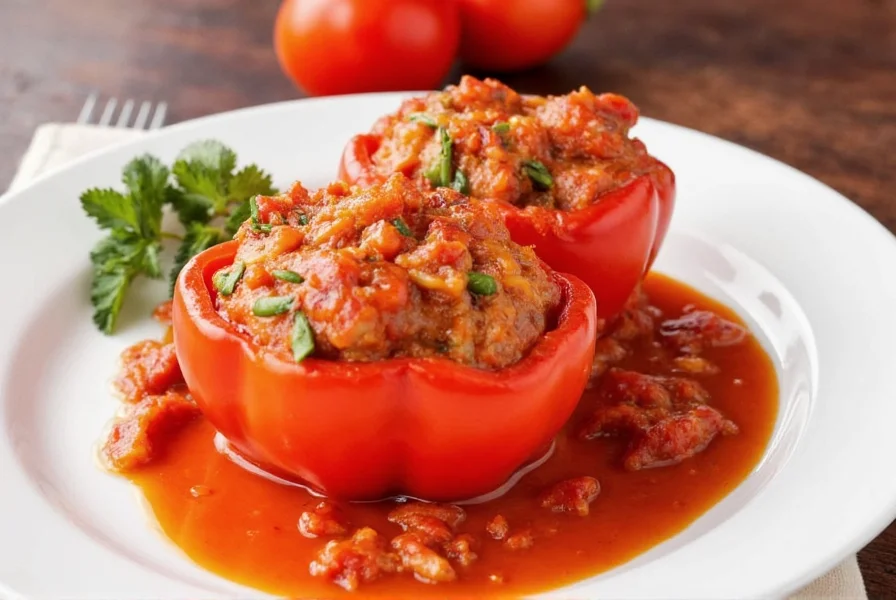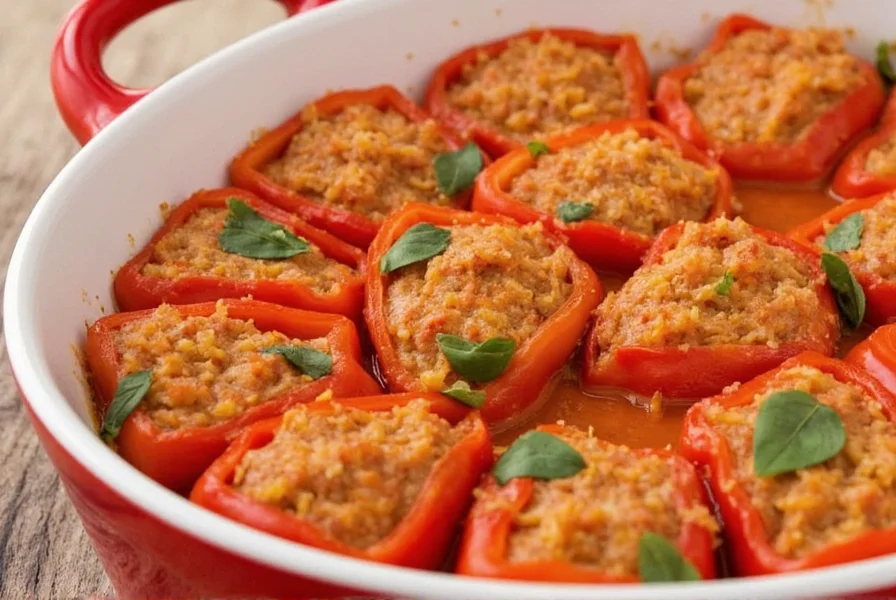Filled paprika, also known as stuffed bell peppers, are whole peppers filled with a mixture of ingredients like rice, ground meat, vegetables, and spices, then baked until tender. This versatile dish appears in cuisines worldwide, with Hungarian paprika stuffed peppers being among the most famous variations. Proper preparation involves parboiling peppers, using the right filling ratio, and baking at 375°F (190°C) for 30-40 minutes to achieve perfectly cooked peppers without sogginess.
Stuffed bell peppers represent one of the world's most universally beloved comfort foods, with cultural variations spanning continents. Whether you're exploring traditional Hungarian filled paprika recipes or creating your own vegetarian stuffed pepper variations, understanding the fundamentals transforms this simple dish into a culinary masterpiece. The key to exceptional filled paprika lies not just in the filling ingredients but in proper pepper preparation and baking technique.
The Global Journey of Filled Paprika
Bell peppers, native to Central and South America, became culinary staples after European colonization. Filled paprika evolved independently across cultures as cooks sought creative ways to use these vibrant vegetables. In Hungary, filled paprika (töltött paprika) became a national dish featuring minced meat, rice, and generous paprika seasoning. Spain developed pimientos rellenos with cheese and seafood fillings, while Middle Eastern cuisines created yalanchi with spiced rice and pine nuts.

Essential Components for Perfect Stuffed Peppers
Creating exceptional filled paprika requires attention to three critical elements: pepper selection, filling composition, and cooking method. Understanding these components ensures restaurant-quality results every time.
Pepper Selection and Preparation
Choose firm, brightly colored bell peppers with flat bottoms that stand upright. Red, yellow, and orange varieties offer sweeter flavor than green. Before filling, slice tops horizontally, remove seeds and membranes, then parboil for 3-4 minutes. This crucial step prevents peppers from becoming mushy during baking while maintaining their structural integrity.
Filling Composition Guidelines
The ideal filling ratio maintains structural integrity while delivering flavor. Follow this professional chef-recommended proportion:
| Ingredient Category | Proportion | Function |
|---|---|---|
| Base (rice/quinoa) | 30% | Absorbs moisture, provides structure |
| Protein (meat/beans) | 40% | Flavor foundation, nutritional value |
| Veggies & Aromatics | 25% | Moisture, texture, flavor complexity |
| Liquid (broth/tomato) | 5% | Steam generation, prevents dryness |
Step-by-Step Filled Paprika Preparation
Follow this professional method for perfectly cooked stuffed peppers every time:
- Prepare peppers: Cut tops, remove seeds, parboil 3-4 minutes, drain upside down
- Make filling: Sauté aromatics, brown protein, mix with cooked base and seasonings
- Fill peppers: Pack filling firmly but not tightly (peppers expand during cooking)
- Prepare baking dish: Line with tomato slices or arrange in broth-filled dish
- Bake: Cover with foil, bake at 375°F (190°C) for 30 minutes, uncover for final 10 minutes
- Rest: Allow 5 minutes before serving to set filling structure
Cultural Variations Worth Exploring
While Hungarian filled paprika remains iconic, these regional variations offer distinctive flavor profiles:
- Hungarian Töltött Paprika: Ground pork/beef with sweet paprika, served with sour cream and boiled potatoes
- Spanish Pimientos Rellenos: Cheese-stuffed (often Idiazábal), sometimes with seafood, in tomato sauce
- Middle Eastern Yalanchi: Grape leaf-inspired rice filling with mint and allspice, tomato broth
- American Midwest Style: Ground beef, rice, tomato soup base, baked in casserole dish
- Mexican Chile Relleno Style: Cheese-filled, battered and fried, with tomato-chile sauce
Advanced Techniques for Culinary Excellence
Professional chefs employ these methods to elevate basic stuffed peppers:
- Double-roasting peppers: Briefly char peppers before filling for smoky depth, then bake as usual
- Layered flavor building: Sear filling ingredients separately before combining for complex taste
- Moisture control: Add breadcrumbs to absorb excess liquid from vegetables
- Flavor-infused cooking liquid: Use mushroom or meat broth instead of water for baking
- Finishing techniques: Broil briefly at end for caramelized top without overcooking peppers
Nutritional Profile and Dietary Adaptations
A standard serving of traditional meat-filled paprika provides approximately:
- 320-380 calories
- 18-22g protein
- 10-14g fat (varies with meat choice)
- 45-55g carbohydrates
- Significant vitamin C, vitamin A, and fiber from peppers
For dietary adaptations:
- Vegetarian stuffed pepper variations: Substitute lentils or textured vegetable protein for meat
- Low-carb option: Replace rice with cauliflower rice (squeeze out excess moisture)
- Dairy-free version: Omit cheese toppings, use nutritional yeast for umami
- Gluten-free preparation: Ensure broth and seasonings are certified gluten-free
Troubleshooting Common Filled Paprika Problems
Address these frequent issues with professional solutions:
- Soggy peppers: Parboil properly, avoid overfilling, use moisture-absorbing ingredients like breadcrumbs
- Collapsed peppers: Choose firm varieties, don't overcook, maintain proper filling ratio
- Dry filling: Include adequate liquid component (5% of filling), don't overbake
- Burning bottoms: Place on tomato slices or in shallow broth, rotate dish during baking
- Peppers tipping over: Trim bottoms slightly for stability, use ring mold or egg carton
Serving and Storage Recommendations
For optimal enjoyment, serve filled paprika immediately after the 5-minute resting period. Traditional Hungarian presentation includes a dollop of sour cream and boiled potatoes. Leftovers maintain quality for 3-4 days refrigerated or 2-3 months frozen.
When reheating, add a teaspoon of broth to each pepper and cover with foil to prevent drying. Microwave reheating requires careful monitoring to avoid rubbery texture. For meal prep enthusiasts, prepare components separately and assemble just before baking for best results.
Frequently Asked Questions
What's the best way to prevent stuffed peppers from becoming soggy?
Prevent sogginess by parboiling peppers for 3-4 minutes before filling, using the proper filling ratio (30% base, 40% protein), adding moisture-absorbing ingredients like breadcrumbs, and placing peppers on tomato slices or in shallow broth during baking. Avoid overfilling, as peppers expand during cooking.
Can I make vegetarian stuffed peppers that hold together well?
Yes, successful vegetarian stuffed peppers require careful moisture management. Use cooked lentils or textured vegetable protein as protein base, include 30% cooked rice or quinoa as structural base, add breadcrumbs to absorb excess liquid, and squeeze moisture from vegetables like zucchini. Cauliflower rice works but must be thoroughly dried before use.
How do traditional Hungarian filled paprika differ from other stuffed pepper recipes?
Traditional Hungarian filled paprika (töltött paprika) features ground pork or beef mixed with rice and generous amounts of sweet paprika, baked in tomato or broth sauce, and served with sour cream and boiled potatoes. Unlike some variations, Hungarian style emphasizes paprika as both ingredient and namesake, uses minimal additional vegetables in the filling, and typically features whole, upright peppers rather than sliced preparations.
What temperature and baking time produces perfect stuffed peppers?
Bake stuffed peppers at 375°F (190°C) for optimal results. Cover with foil for the first 30 minutes to steam the peppers, then uncover for the final 10 minutes to allow browning. Total baking time should be 30-40 minutes, depending on pepper size. The peppers are done when tender but still holding their shape, and the filling reaches 165°F (74°C) internal temperature.











 浙公网安备
33010002000092号
浙公网安备
33010002000092号 浙B2-20120091-4
浙B2-20120091-4